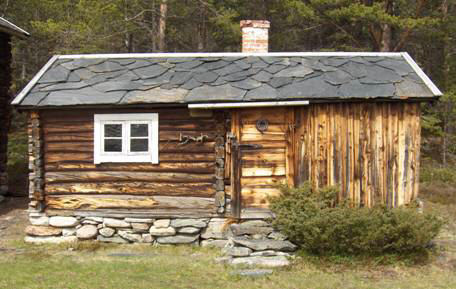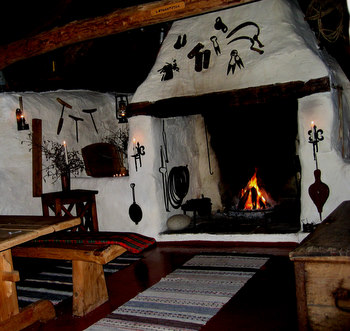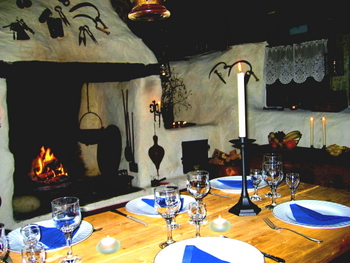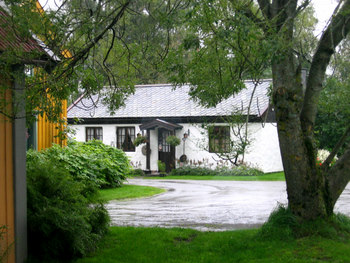|
Eldhuset
This Eldhus, picture above, was originally built by Semund Oleson Frankmoen in 1847. In 1948, it was placed on a farm called Bekken, located in Grimsbu, Folldal, Norway. On the old Norwegian farms, Eldhuset was one of the most important buildings on the farm. It was a small one-room house - you might call it "the Norwegian kitchen" of old. It usually had more than one source of fire. They had a gruve, a type of fireplace with a chain to hang a pot on for cooking. For baking, they had a type of stone oven. They also had a round stove where they placed a large round griddle, and also it would fit stor-gryta, the big pot. Eldhuset was mainly utilized for the many tasks pertaining to food preparation, but other tasks as well. It was the central workplace for the woman on the farm. It housed a long workbench, arbeidsbenk in Norwegian, and a long table, called langbord. It often had a couple of beds for guests and baking ladies, bakstekjerringer in Norwegian, that would come to the farm and stay for a week or so making flatbrød, lefse and småbrød. Flatbrød was eaten every day, lefse and småbrød was a dessert and not eaten every day. Tasks, such as butter churning, and all cheese-making, ysting in Norwegian, took place in eldhuset. Also, bread baking, lefse, flatbrød, and småbrød baking and all food preparation including salting and/or canning of meats, berries, and fruit took place in that multi-purpose food making center.
located in Devold, Romsdal, Norway Notice the tools from "The Olden Days" decorating the fireplace and the wall to the left. Eldhuset, "the"firehouse" had a fireplace (gruve in Norwegian) built of stone. It burned wood. This griddle (helle or takke) was used to bake lefse, flatbrød and rømmebrød also called småbrød, which was prepared on bakstefjøla. Eldhuset also had a Bakstefjøl, which was a large wooden board/baking surface that was used for rolling out the dough. It was about 4' x 5' surface with a frame on three sides so the flour wouldn't end up on the floor. On bakstefjøla, you would find a bakepinne, a long wooden stick, which I call a "lefse flipper". Here in the states, it is called a lefse turner. Last, but not least, you would find a necessary tool, called kjevle, a rolling pin with ridges, which is a must to make Norwegian flatbread, småbrød, and lefse. In spring and in the fall, the farmers hired "baking ladies" (bakstekjerringer) that would come to the farm and spend many days baking lefse, flatbrød, and småbrød also called rømmebrød (thin sour cream bread). Often, "the baking ladies" were aunts or grandmas that were highly skilled in the ancient baking art of rolling out the dough into large, thin disks, (leiver in Norwegian) They baked hundreds of pieces/disks of each kind. The disks were cut into quarters (pie-shaped) and stacked and stored in chests. They made enough bread to feed the family for months. Småbrød/rømmebrød was also made on the bakstefjøla, but that was/is a type of dessert. Småbrød is crisp, sweet, contains sour cream, and is super delicious. It is rolled out thin like lefse, cut into quarters, and stored dry in an air-tight container. Before serving, it was spread with butter and sprinkled with cinnamon and sugar. Småbrød and lefse are still enjoyed in Norway today. Oh, and they are so unbelievably yummy. The baked goods were kept in dry storage in special wooden chests in Stabburet, which was a type of storehouse used as a pantry to keep all their food. Eldhuset was also used for parting out animals after butchering and preparing the meats for salting, smoking, curing, and drying. It was also used for making syltaflesk, lammerull, and fåremør. Mør is a type of cured, dried sausage made from lamb, which is still made in Norway today. It is kind of a jerky sausage. It is enjoyed as tasty sandwich meat and/or as a snack. Other kinds of sausages were also made in Eldhuset, such as blodpølse (blood sausage) and sausages made of beef, lamb, or pork.
Stabburet was also used to prepare various meats, such as fenalår, which is cured and dried leg of lamb. The lamb was first placed in salt brine; rinsed and dried off. It was then covered with cloth, today, cheesecloth is used to protect leg of lamb from dust, dirt, and insects. The meat was hung up in the rafters in stabburet, to dry for many weeks. Here in the USA, we might call it a type of jerky. From pork, they made røkt skinke, (a type of smoked ham, but smoked ham is not the same as Røkt skinke), and also they made a salted and dried skinke, which is kind-of Norway's answer to prosciutto. To preserve the meat, they salted it in large wooden vats, which they kept in Stabburet. Smoking of meat and fish took place in the "Smoke House". Salted ham, was sometimes smoked and dried, which is called røkt skinke, and sometimes it was salted and dried, which was/is called spekeskinke. The meat or fish was dried in the rafters. The food was stored in Stabburet, a type of storehouse, which was another small house on the farm used for food storage. 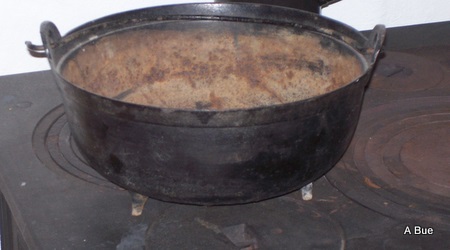 Old Norwegian Iron Pot Storgryta When the griddle/helle was removed storgryta (the large pot) could be used for cooking porridge (graut), soups, stews, and other foods. The fireplace (gruva) had an iron chain with hooks where you could hang storgryta. The chain had hooks so one could "adjust" the heat to the temperature needed". Obviously, the closer the pot was to the flame - the hotter the temperature. Don't you prefer the knobs on your stove? This huge pot (gryte) was also used to make soap; boiling white clothes and to provide hot water for butchering. The cooking pots in the old days were made of iron. They had a round bottom and with three legs. The objective, of having legs on the pot was so that the pot would stand sturdy on a flat surface. Initially, ovens were made of stones where they could place a griddle, or remove the griddle to make room for a very large pot, storgryta, in Norwegian. Later the cooking stove was made of iron with a surface made with removable rings, so they could adjust the opening to accommodate various size pots, as well as a large griddle. So then there was no longer a need for the chain in gruva. But that invention came later on.
When you visit Åndalsnes, Romsdal, skip over to Devold Farm, where they can give you a comfortable place to stay. Call ahead to make arrangements to experience Norwegian history and enjoy excellent food at Eldhuset Devold, where they converted Eldhuset, which is the oldest building on the property into a cozy and quaint restaurant/conference room. They will serve dinner to groups of up to 20 guests. 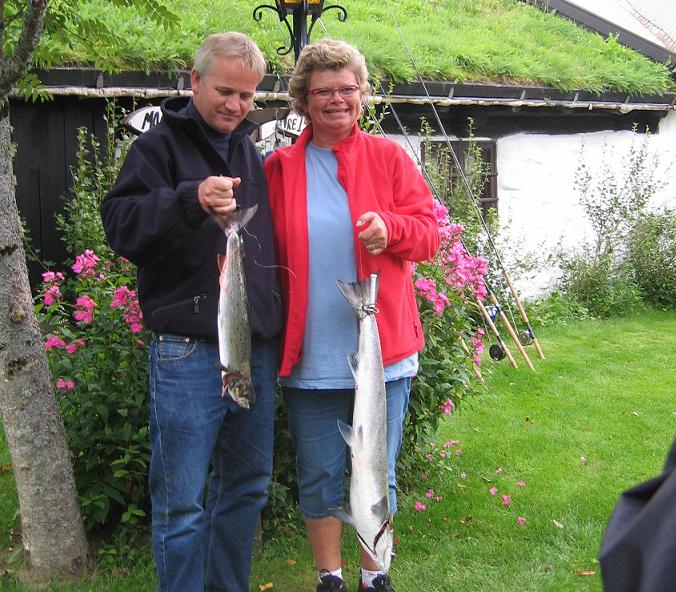 Salmon Fishing at Devold And if the sport of salmon fishing gives you a thrill, they will arrange for you to have the time of your life. All you to do is call this number: (011) (47) 71 22 15 18 and ask for Per Devold or send mail to post@devoldgard.no to make a reservation. Just tell them that Anne Grete from www.norway-hei.com sent you.
All Rights Reserved
|



